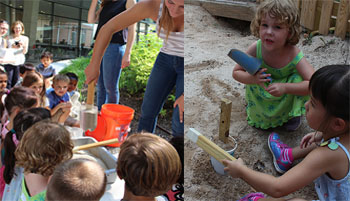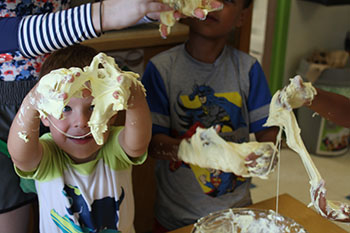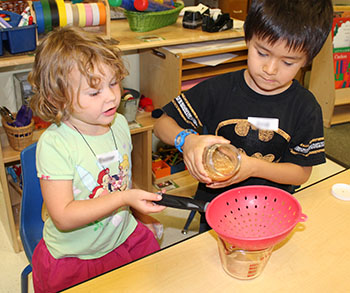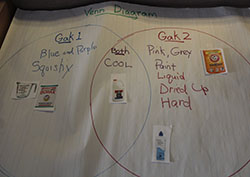Week 4
The Scientific Method
Although a little complicated for this age, the scientific method was introduced with six steps: 1 Question, 2. Research, 3. Hypothesis, 4. Experiment, 5. Analysis, and 6.Conclusion. To illustrate these concepts, Ms. Damron presented three containers of liquids and asked the children what they thought might happen if she mixed them. The children all shouted that the blue and yellow liquids would turn green because they had been "researching" color mixing in the previous weeks. This hypothesis proved to be correct but when the third liquid (oil), was mixed with the colored water the children were surprised. A discussion ensued and more questions arose. During the remainder of camp children were reminded of one or two of these steps as they continued to experiment with different Gak recipes.

The Joint Quantum Institute at the University of Maryland does physics research and with a connection from one of the CYC parents, the Green Room class was invited to explore some mixing concepts. Charlotte Slaughter and Dara Storer from the institute, introduced the children to a large mixing machine filled with small beads. A heavy ball was shown to the children and they were asked if it would sit on top of the beads or sink. The ball sat on top of the beads until the mixing machine was turned on. The mixture of beads began to rotated and the ball sank to the bottom.
Experiments with a lighter ball were done too and it tended to gravitate to the top when the machine was on. Slaughter and Storer then took the children outside for an experiment with sand where they had the children pack sand in to a vessel with a stick planted in the middle of it. After hitting the sides of the container with another stick and packing the sand in tight the stick was able to be lifted up without coming out of the vessel. This experiment was recreated back at the CYC playground without success.
Many kinds of Gak, Slime, Flubber etc.-

This was the week of slime, with four different recipes being tried. Traditional slime made with borax and white glue was the first and most successful slime tried. Next, saline solution was used as a catalyst in place of the borax and then came a recipe with clear glue, glitter, and liquid starch. The liquid starch on hand did not work, it was thought to have been on the shelf for over 10 years and perhaps that was why. The last slime, a fluffy slime, made with shaving creme, appeared more like bubble gum during the early stages and made a glorious mess. After playing with it for a while the mixture settled down in to a workable consistency.
Mixtures and Solutions

Dr. Matt Daniels a biologist, and grandfather to one of the campers, volunteered his time to come and do some mixing experiments with the children. Three different solids were added to a jar of water and the children observed each as they put them in. The first was sugar and it was noticed that it dissolved right away and made a solution. Campers were asked to predict what would happen when the next two ingredients were added, sawdust and sand. Would they dissolve or not? Children made their hypotheses and followed through with the experiment. As the children combined the ingredients they noted the sand sank to the bottom and some of the sawdust floated.
The next portion of this activity was to try and separate the three items out of the water. Campers recalled their trip to the Chemistry building where the scientist there had used a sophisticated machine, called a Rotary Vap, to extract salt from water. This time a colander and eventually a sieve with a coffee filter were used. Children were delighted to see how clear the water became after using the sieve, but after tasting the results they found the sugar was still present.
